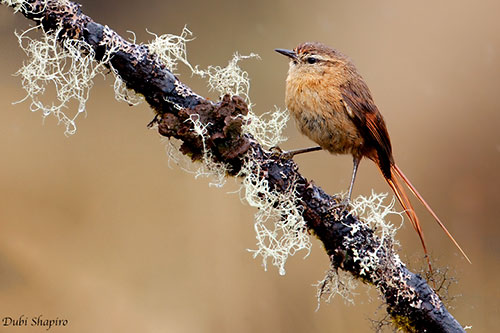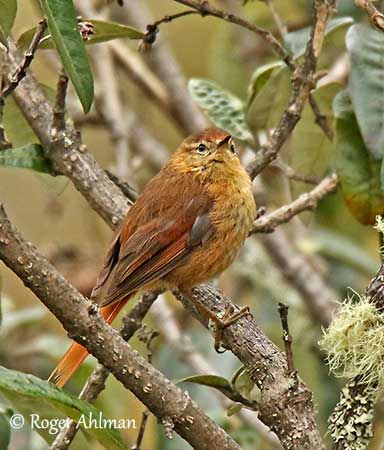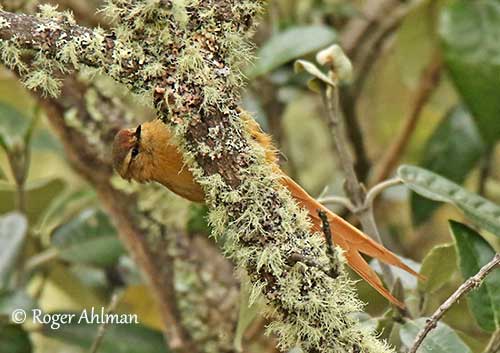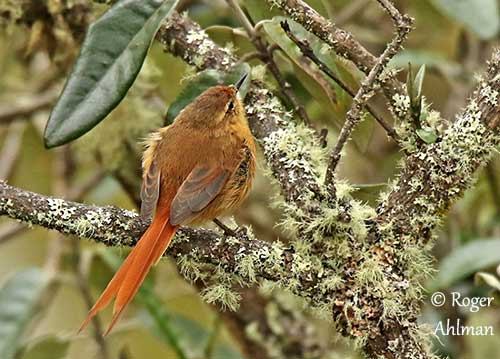
Fr: Synallaxe fauve
Ang: Tawny Tit-Spinetail
All: Roststirn-Meisenschlüpfer
Esp: Tijeral de Yánac - Peru: Tijeral Leonado
Ita: Codaspino cincia fulvo
Nd: Bruine Meesstekelstaart
Sd: gyllenbrun sprötstjärt
Photographers:
Roger Ahlman
Pbase Galleries Peru and Ecuador
Dubi Shapiro
Dubi Shapiro Photo Galleries
Text by Nicole Bouglouan
Sources:
HANDBOOK OF THE BIRDS OF THE WORLD Vol 8 By Josep del Hoyo-Andrew Elliott-David Christie - Lynx Edicions - ISBN: 8487334504
BIRDS OF SOUTH AMERICA – Passerines - by Robert S. Ridgely and Guy Tudor – HELM Field Guides – ISBN: 9781408113424
BIRDS OF PERU by Thomas S. Schulenberg, Douglas F. Stotz, Daniel F. Lane, John P. O’Neill, Theodore A. Parker III–Princeton University Press 2007– ISBN: 978-0-691-13023-1
Neotropical Birds – Cornell Lab of Ornithology
Wikipedia, la enciclopedia libre
Tawny Tit-Spinetail
Leptasthenura yanacensis
Passeriformes Order – Furnariidae Family
INTRODUCTION:
The Tawny Tit-Spinetail is a member of the family Furnariidae. It occurs at high elevations in the Andes, from 2,900 to 4,600 metres, from the Andes of W Peru to extreme NW Argentina. It is usually found in patches of Polylepis woodland and scrub.
It feeds mainly on small arthropods and occasionally consumes some plant matter. This monogamous species nests in a dome-shaped structure placed in Polylepis tree.
The Tawny Tit-Spinetail is described as local and uncommon, and it is patchily distributed. It is threatened by degradation and destruction of the habitat, and the population is slowly declining.
The Tawny Tit-Spinetail is currently listed as Near Threatened.
DESCRIPTION OF THE BIRD:
Biometrics:
Length: 15-16 cm
Weight: 10-12 g
The Tawny Tit-Spinetail has rufous-brown upperparts, with rufous-chestnut wings, uppertail-coverts and tail. The tail is very long and graduated, with slightly thickened shafts on central pair of rectrices. The fork is conspicuous.
The underparts are uniformly tawny, but the chin is paler, whereas flanks and undertail-coverts are darker.

On the head, the forehead is dark chestnut and the crown is mostly dark brown and duller. There is a conspicuous pale buff supercilium extending from lores to rear of ear-coverts. It is more or less dark, depending on the range.
The bill is long and fairly thin, blackish to dark grey, with sometimes pinkish base of lower mandible. The eyes are dark brown. Legs and feet vary from brown to grey.
Male and female are similar.
The juvenile may have some weak bars on the breast. The forehead is often less rufous than in adults. The rectrices are blunt-tipped.
RANGE:
The Tawny Tit-Spinetail is found in W and SE Peru ((Cordillera Blanca in Ancash, N Lima, Apurímac, Cuzco and Puno), then S to WC Bolivia (La Paz, Cochabamba, Chuquisaca, Tarija and Potosí), and NW Argentina (Jujuy and Salta).
HABITAT:
The Tawny Tit-Spinetail is mainly found in Polylepis woodland. It also frequents montane scrub including shrubbery, small patches of mixed plant species and other bushes, usually surrounded by grassland or talus.
The species occurs between 3,200 and 4,600 metres of elevation, although it is mainly found around 2,990 metres in NW Argentina.

CALLS AND SONGS: SOUNDS BY XENO-CANTO
The calls of the Tawny Tit-Spinetail include quiet, liquid “tchp” notes and a short “eep”.
The song is a simple trill “tree-ee-ee-ee” lasting 3-5 seconds and ending with an extra note and a short trill “trrrrrrree-teeteerr”. It also produces a long accelerating series of loud chips “tchp tchp tchp-tchi tchi’tchi’tchi’tchi’tchu-tchp”.
BEHAVIOUR IN THE WILD:
The Tawny Tit-Spinetail feeds primarily on small arthropods gleaned from the vegetation.
It forages at all forest levels from the understorey to the canopy, and occasionally on the ground. It is always very active and moves quickly among Polylepis branches.
It gleans prey from leaves, twigs and bark, and can be seen clinging vertically or upside-down to reach the food.
This bird often flicks both wings and tail. It often joins mixed-species flocks.

The Tawny Tit-Spinetail is monogamous and can be seen in pairs probably throughout the year. Small groups are observed in large areas, moving across woodland patches, probably family groups.
The breeding behaviour is very poorly known, but we can suggest that the very long, graduated tail and the bright wing pattern are enhanced by adapted postures during the displays.
This species nests in a dome-shaped structure, typical of Furnaridae species. See Page 3 : Furnariidae (Ovenbirds).
The Tawny Tit-Spinetail is resident, but it probably performs some altitudinal movements according to food availability.
It moves across patches of woodland by flying close to the ground. The short wings and the very long tail are not adapted to long-distance movements.

REPRODUCTION OF THIS SPECIES:
The breeding season probably occurs during the wet season (October-November) in S Andes, providing food to the birds. But this period varies slightly according to the range.
The Tawny Tit-Spinetail builds a dome-shaped structure with dried grass, of about 25 centimetres in diameter. There is an entrance on the side. Inside, the nest is lined with softer material such as hairs, vegetal down and fibres, and probably some feathers.
This rounded structure is built on horizontal branch, about 2-2,5 metres above the ground in Polylepis tree.
Depending on the species, the female lays 2-4 eggs (up to 6) and the incubation lasts 15 to 22 days. The young fledge between 15 and 20 days after hatching. Both adults feed the chicks.
More information is needed about the nesting behaviour of this species.
PROTECTION / THREATS / STATUS:
The Tawny Tit-Spinetail is rare to locally common throughout the range.
This species is mainly threatened by degradation and destruction of its habitat caused by heavy grazing by livestock and uncontrolled use of fire, preventing Polylepis regrowth following cutting for timber and others. Intensification of agriculture and afforestation involve erosion and degradation of soil.
The global population is unknown, but the species is patchily distributed and uncommon. This population is suspected to be declining slowly.
The Tawny Tit-Spinetail is currently listed as Near Threatened.
